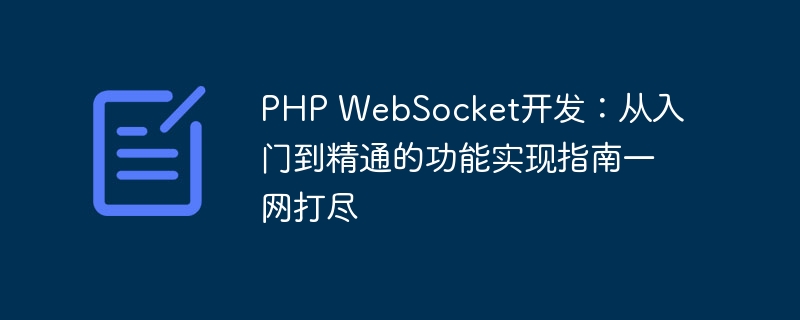

PHP WebSocket Development: A comprehensive guide to implementing functions from entry to proficiency
With the continuous development of Internet technology, real-time communication has become a must for many Web applications One of the functions. As a full-duplex communication protocol, WebSocket can establish a persistent connection between the server and the client and achieve real-time two-way communication, which has become one of the key technologies for real-time application development. For PHP developers, how to use PHP to develop WebSocket applications has become a required course.
In this article, we will take you from entry to proficiency, covering all functions of PHP WebSocket development in one place.
1. Understand the WebSocket protocol
First of all, as a PHP developer, we first need to understand the basic principles and working methods of the WebSocket protocol. The WebSocket protocol is based on the HTTP protocol, which allows the establishment of a persistent connection between the client and the server and enables real-time two-way communication. Unlike the traditional HTTP request/response model, WebSocket can push data from the server to the client in real time, greatly improving the efficiency and user experience of real-time applications.
2. Build a WebSocket server
The second step is to build a WebSocket server to handle client connections and message push. In PHP, you can use the Swoole extension to build a WebSocket server. Swoole provides many powerful functions and APIs, which can easily realize the development of WebSocket server. In the process of building the server, we need to define the processing logic of related messages, such as connection establishment, disconnection, message reception, etc.
3. Implement basic functions: connection establishment and disconnection
After building the WebSocket server, we need to implement some basic functions, such as connection establishment and disconnection. When the client establishes a connection with the server, the server needs to perform a series of handshake operations to ensure the normal establishment of the connection. When the connection is disconnected, the server also needs to respond to the disconnection event and release related resources.
4. Implement the reception and sending of messages
Next, we need to implement the functions of receiving and sending messages. When a client sends messages to a server, the server needs to receive and process those messages. When the server pushes a message to the client, the server also needs to send the message to the corresponding client. These functions can be implemented by listening to the onMessage event of WebSocket, and the specific logic can be expanded and optimized as needed.
5. Handling user authentication and message filtering
In addition to basic connection and message functions, actual WebSocket applications also need to deal with some other issues, such as user authentication and message filtering. In WebSocket applications, we usually need to authenticate users to ensure that only legitimate users can access and use server-side functions. In addition, sometimes we also need to filter messages to exclude some messages that are illegal or do not need to be processed.
6. Combination with other components
In actual development, WebSocket is often not an isolated function and often needs to be combined with other components. For example, we may need to combine WebSocket with a database to implement some functions involving data persistence. In addition, we can also combine WebSocket with other Web frameworks to achieve more flexible and powerful applications.
7. Performance optimization and security protection
Finally, we can also perform performance optimization and security protection on WebSocket applications. For performance optimization, we can improve the processing capabilities of the server through multi-process or multi-threading. In terms of security, we can conduct more stringent verification of user identities to prevent malicious attacks and illegal use.
Conclusion
Through the introduction of this article, I believe that you have a more comprehensive and in-depth understanding of the functional implementation of PHP WebSocket development. Whether you are getting started or mastering, the key lies in continuous practice and learning. I hope this article can bring you some inspiration and help, and I wish you go further and further on the road of WebSocket development!
The above is the detailed content of PHP WebSocket development: a comprehensive guide to function implementation from entry to proficiency. For more information, please follow other related articles on the PHP Chinese website!